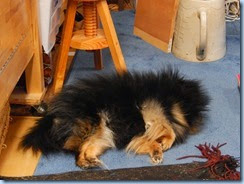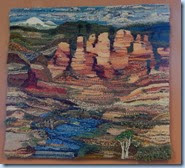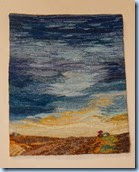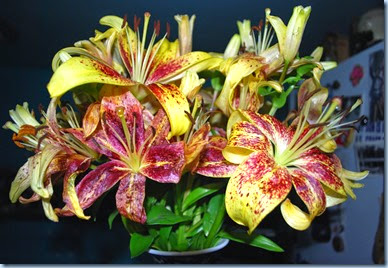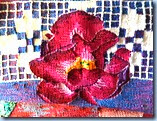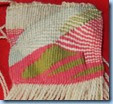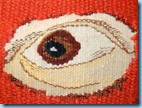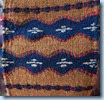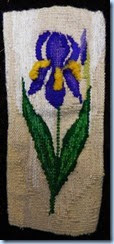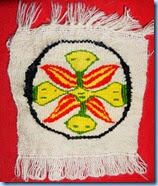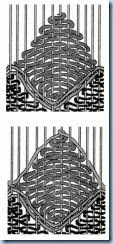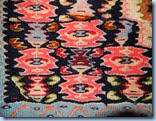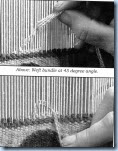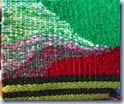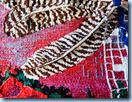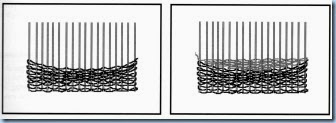This has been an interesting spring. I have been on several major  trips.Sedona, Cincinnati, Tec Nos Pec ,Santa Fee, seen a great many private students, the coast and Bend and numerous points in between. BUT, the hardest trip I have been on has been a mental trip of working on a piece about one of my Gramma’s. It was hindering me so badly with unresolved issues-hers and mine- that I decided to
trips.Sedona, Cincinnati, Tec Nos Pec ,Santa Fee, seen a great many private students, the coast and Bend and numerous points in between. BUT, the hardest trip I have been on has been a mental trip of working on a piece about one of my Gramma’s. It was hindering me so badly with unresolved issues-hers and mine- that I decided to shelf it for the time being. I am now working on a piece about my Grandfather and the charmed life I led when I was with them while I was growing up. Someday I’ll reconcile or at least come to terms with my other Gramma, but not now.
shelf it for the time being. I am now working on a piece about my Grandfather and the charmed life I led when I was with them while I was growing up. Someday I’ll reconcile or at least come to terms with my other Gramma, but not now.
I have another small loom to the side that I am going to be doing some small studies of things I have always wanted to weave, but couldn’t figure out where to put them in larger 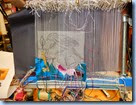 designs. On the same loom I decided to see what would happen if I tried having a piece(s) that world be more of a daily calendar type thing-sort of in the nature of what Tommye,Janette and Jan’s group does. It’s not going well so far. I admire the work they do with calendar type weavings, but in on the calendar pieces. What I am discovering for myself is it gets in the way of the focus and concentration I need to have on a given piece.It’s almost more of an irritation then any thing else. So, I am going to keep trying and see if I just need an attitude shift in someway or maybe there just not for me to do. I’ll see.
designs. On the same loom I decided to see what would happen if I tried having a piece(s) that world be more of a daily calendar type thing-sort of in the nature of what Tommye,Janette and Jan’s group does. It’s not going well so far. I admire the work they do with calendar type weavings, but in on the calendar pieces. What I am discovering for myself is it gets in the way of the focus and concentration I need to have on a given piece.It’s almost more of an irritation then any thing else. So, I am going to keep trying and see if I just need an attitude shift in someway or maybe there just not for me to do. I’ll see.
| Warning- This is going to be sort of an odd blog in 3 chapters or perhaps 4. I found while I was away teaching my “More class” that I really didn’t have the backup materials that I needed for teaching my method of warping a mirrix loom-which is both faster and easier then using the wrap around bar system that many use or try to use and eccentric weaving. So, I wrote to rather long sections on doing both that I am going to publish as blog entries for my students. |
A 3 stage trip-
Stop 1- Sedona, Arizona
I enjoyed teaching in Sedona. The weather was beautiful! It’s a beautiful place especially out away and into the red rocks where we are at. It was kinda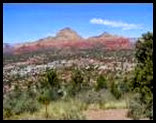 wild and very natural.One could look out and watch the birds while weaving and teaching, which I really enjoyed. Unfortunately my camera battery refused to stay charged and so I have no pictures I wish I had taken more photo’s of the area and the class, but I discovered a new allergy complete with runny nose that sort of limited my picture taking. I really enjoyed the group. I am hoping to teach there again in the fairly near future. My “More” class is fun to teach because it’s based on those skills already learned and pushing those skill further.
wild and very natural.One could look out and watch the birds while weaving and teaching, which I really enjoyed. Unfortunately my camera battery refused to stay charged and so I have no pictures I wish I had taken more photo’s of the area and the class, but I discovered a new allergy complete with runny nose that sort of limited my picture taking. I really enjoyed the group. I am hoping to teach there again in the fairly near future. My “More” class is fun to teach because it’s based on those skills already learned and pushing those skill further.
I did see an interesting show in Cottonwood. It was in the Clarksdale library.My notebook got wet somewhere along the way and the ink ran so I called Carol VanSandt to retrieve the information and she’ll give it to me when she gets moved up to Southern Oregon this month. It was a really great fiber show.The pear and the orange sunset with rocks are done in embroidery floss by Carol VanSandt. Linda Pierce wove the orange sunset. Mary Liggit wove the other small framed piece. The larger wool pieces which are actually much better shaped and squarer were woven by about 12 weavers who were in a group project in the Verdi Valley Guild 
STOP 2
Teec Nos Pec, Navajo Nation, Arizona
Diane picked me up in Cottonwood and we headed out. The country is very different then what I am used to and know. Rock formations just pop up out vast flat areas. Rich colour is everywhere, but not the vivid greens-created with an entirely different palette. I am used to.The distances feel greater and vaster. In places the colour is like some one took a large brush and left brush strokes of reds and pinks. We stopped at the Navajo National Museum in Window Rock.The exhibits were fascinating. I especially enjoyed one called a Beautiful Life.We finally arrived in Tec Nos Pec after taking a very long short cut.
I loved visiting with my friend Roy Cady. It was fun 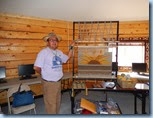 talking as weaver to weaver. Our weaving styles and/or philosophy are more similar then dissimilar.I enjoyed talking with several of the older weavers with Arieta as a translator. Roy is a traditional weaver who enjoys pictorial tapestry, but with his own distinctive style. I love weaving just about anything that is pictorial. I first met Roy at a workshop in Santa Fe that was being taught by Jean Pierre Larochette, Yael Lurie and Phillipe Playier. The piece on the loom he has since finished and it is for sale on his web site.
talking as weaver to weaver. Our weaving styles and/or philosophy are more similar then dissimilar.I enjoyed talking with several of the older weavers with Arieta as a translator. Roy is a traditional weaver who enjoys pictorial tapestry, but with his own distinctive style. I love weaving just about anything that is pictorial. I first met Roy at a workshop in Santa Fe that was being taught by Jean Pierre Larochette, Yael Lurie and Phillipe Playier. The piece on the loom he has since finished and it is for sale on his web site. 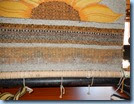 Roy, of course, is the better weaver because his ends don’t show, but I’ll get better-grin! I promised the “Older One.”
Roy, of course, is the better weaver because his ends don’t show, but I’ll get better-grin! I promised the “Older One.”
This is a detail of the twills Roy has used so effectively in the piece.I am very fascinated with the contrast between the pictorial and the use of the twills. Roy is a great weaver and makes it look so easy. If I did this right you should be able to see the finished piece and an announcement for an exhibit he has going on. (Diné(Navajo) Master Fiber Artist & Navajo-Churro Sheep Herder Shimá's Gifts-My Mother's Gifts)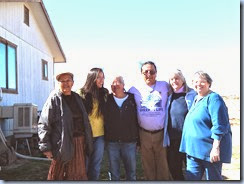
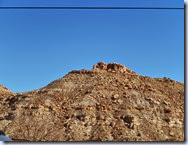
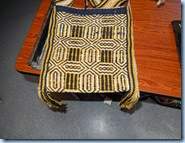
The bag is one that was done by his Shima Mary Clah. The mountain of rocks is I think called Goat Rocks, but to my way of thinking will always remind me of Monkeys because of a story Roy told me about escaped Monkeys, which reminded me of my Grandmother and her tales of what would happen to children that disobeyed and the drumming of the birds wings.
STOP 3
Santa Fe, N.M.
This is probably one of my favourite places to travel and visit. It’s a blending of new and old, traditional and non traditional. The Plaza is one of the few places I enjoy being a tourist. I love picking up trinkets and needful things(?) such as wind ups and Milagros. I enjoyed talking to the native American artists that were selling along one walls of the Old Plaza. I bought a copper torque style and jasper bracelet that I love . Had a great time talking about copper and where he was from. I stopped in for a few minutes and visited with Rebecca Metzoff in her studio. It was fun comparing a few notes and seeing more of her work. 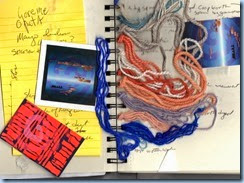
Two of the 20 pages of notes that I am still sorting through on everything that I saw, tried to absorb, and talked about with others. While trying to have a good time hanging out with friends Tony and Diane. The business cards are Rebecca Metzoff’s. They are beautiful little works of art that I liberated from her studio. The wool samples are all of the various wools used in the area by regional weavers in Arizona and New Mexico. It also notates to different weaving groups that I want to research as I saw some of their weavings in different shops and galleries.
From there-Santa Fe-I took a train home-2 days of reading writing and sleeping and watching the world change from one eco system to another-one life to another.
STOP 4, 3-weeks later
Cincinnati, Ohio
This was a very anticipated teaching trip that had been planned years in advance. Sometimes guilds schedule 2-3 years in advance and this was one of those. Again, I was teaching my “More” class, lecturing on designing tapestries and loving it. The lecture I gave for the guild is one of my favourite lectures to do because the skills involved can be used to plan any project-whether it be regular weaving, tapestry or even silver. Then emphasis is on the fact that there are no tapestry police and never dumb it down just because it might be difficult!
lectures to do because the skills involved can be used to plan any project-whether it be regular weaving, tapestry or even silver. Then emphasis is on the fact that there are no tapestry police and never dumb it down just because it might be difficult!
Best of all I would be spending any spare time I had with my Good Friend Cathie Beckman and her husband Ed.
There were extra days planned around it for talking, sharing and site seeing. There were also very heavy rains, lightening storms, a wonderful bird feeder with crazy squirrels and not quite spring.
There were 16 or 17 people signed up for the class and many different levels of weaving skills. The workshop was held in a beautiful old house that belongs to the Cincinnati Guild. The questions and wants of the class were exceptional and unique-never a boring minute. We covered optical blending, hatches and a dozen other things-just touching on soumack. The content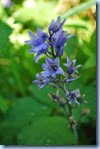 of the class is determined by a questionnaire prior to the class and subject matter for the class is created from the questionnaires.
of the class is determined by a questionnaire prior to the class and subject matter for the class is created from the questionnaires.
I am excited and will be even more excited to see what comes out of the class in the next year. It’s already in the plans for me to teach in 2015 or 2016. I have been asked back, but the date is still up in the air. The class will probably be Soumack and friends+more of More! One of the things that came out of all of the classes was the need for me have better or more support materials for eccentric weaving and more detailed notes for warping Mirrix looms my way.
One last thing About the Cincinnati workshop- To the person in the corner with the short blond hair whose name escapes me that I was talking to in the class about Zentangles. I apologize that I am so bad with names. I can totally  envision you what you were and our conversation, but not your name. This is the book that to be me always reminds me of Zentangles, but are drawn more from nature then Zentangles. It was edited by Christian Stoll and is a Dover book, which means it comes from a book that was published in 1906 so you should be able to use any of these designs with out worrying about copy right or needing special permission to use them.
envision you what you were and our conversation, but not your name. This is the book that to be me always reminds me of Zentangles, but are drawn more from nature then Zentangles. It was edited by Christian Stoll and is a Dover book, which means it comes from a book that was published in 1906 so you should be able to use any of these designs with out worrying about copy right or needing special permission to use them.
In the process of roaming around the city of Cincinnati with Cathie B. and sometimes Ed, there was way more then one can see in a day or two. Two of the many places we went to really stood out to me. We went to the Taft Museum of Art. We/I made some incredibly discoveries. One was Called the Threads of H
more then one can see in a day or two. Two of the many places we went to really stood out to me. We went to the Taft Museum of Art. We/I made some incredibly discoveries. One was Called the Threads of H eaven- Silken legacy of China’s last Dynasty. The exhibit was probably a third tapestry-Dragon Robes, lesser
eaven- Silken legacy of China’s last Dynasty. The exhibit was probably a third tapestry-Dragon Robes, lesser robes and pockets, shoes and purses. I am still sorting out my notes that I eventually wrote in my journals. BUT, here is what I consider to be a remarkable, happy, serendipitous, curious find. It has both eccentric weaving, pick and pick and probably
robes and pockets, shoes and purses. I am still sorting out my notes that I eventually wrote in my journals. BUT, here is what I consider to be a remarkable, happy, serendipitous, curious find. It has both eccentric weaving, pick and pick and probably eccentric pick and pick. AND, best of all the pieces had not been cut apart from the way they had been woven initially and not cut apart. It allows one to see how they were actually woven and the fillers that were were used. It’s a whole ensemble of accessories-fan cases, pockets, eye class case colour and various purses.
eccentric pick and pick. AND, best of all the pieces had not been cut apart from the way they had been woven initially and not cut apart. It allows one to see how they were actually woven and the fillers that were were used. It’s a whole ensemble of accessories-fan cases, pockets, eye class case colour and various purses.
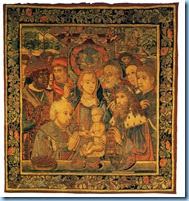 I feel a little like a fair huckster by saying—AND, if that is not enough there was a small devotional tapestry called the Adoration of the Magi woven in Brussels in the first qtr. of the 16th century. It is less then a square yard35 3/4 inches by 33 1/4 inches with wool silk and silver wefts at 24 epi. I have pages of weaving notes to sort out. Unfortunately, it was in a space that was fairly dark and one wasn’t allowed to take pictures and it was mounted a little too high for some one as short as me. But, it did open up another line of research for/and of small devotional tapestries.
I feel a little like a fair huckster by saying—AND, if that is not enough there was a small devotional tapestry called the Adoration of the Magi woven in Brussels in the first qtr. of the 16th century. It is less then a square yard35 3/4 inches by 33 1/4 inches with wool silk and silver wefts at 24 epi. I have pages of weaving notes to sort out. Unfortunately, it was in a space that was fairly dark and one wasn’t allowed to take pictures and it was mounted a little too high for some one as short as me. But, it did open up another line of research for/and of small devotional tapestries.
At the Cincinnati art Museum there was an exhibit called Genius and Grace-Francois Boucher and the generation of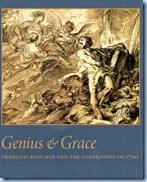 1700.Many of the drawings in this exhibit-Genius and Grace- were done by artist who often designed for tapestries of this period-Boucher, Fragonard, Coypel, Oudry and 29 other possible tapestry designers. By looking at the drawings you can see how they relate to the cartoons and tapestries that were being designed and woven in the 1700. The drawings are incredible to see close up. And made me want to pull out any books I might own on tapestries woven in the 1700’s.
1700.Many of the drawings in this exhibit-Genius and Grace- were done by artist who often designed for tapestries of this period-Boucher, Fragonard, Coypel, Oudry and 29 other possible tapestry designers. By looking at the drawings you can see how they relate to the cartoons and tapestries that were being designed and woven in the 1700. The drawings are incredible to see close up. And made me want to pull out any books I might own on tapestries woven in the 1700’s.
And then again-A Fabulous exhibit of Jewelry designed by Art Smith. Also part of this exhibit were pieces of jewelry by artist such as Calder. It was totally fascinating to me, but I am finally getting to the point that I can look a piece and have a small understanding of how it was done.
From the Village to Vogue: The Modernist Jewelry of Art Smith February 22, 2014 - May 18, 2014 Organized by the Brooklyn Museum of Art, this exhibition features 24 pieces of silver and gold jewelry created by African .... - See more at: http://www.cincinnatiartmuseum.org/explore/exhibitions/current-exhibitions#sthash.IsdAVDj8.dpuf
And, on that note,
it’s time for me to finish
up and post this before it
gets any longer.
